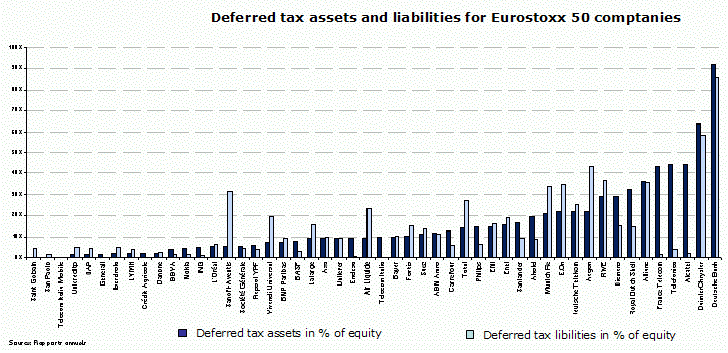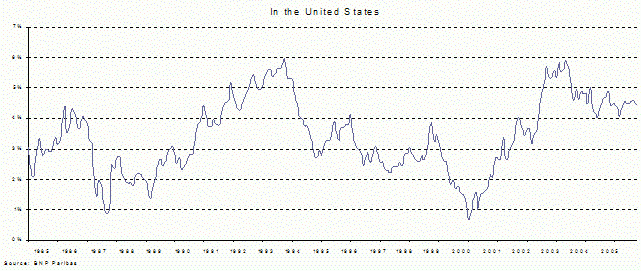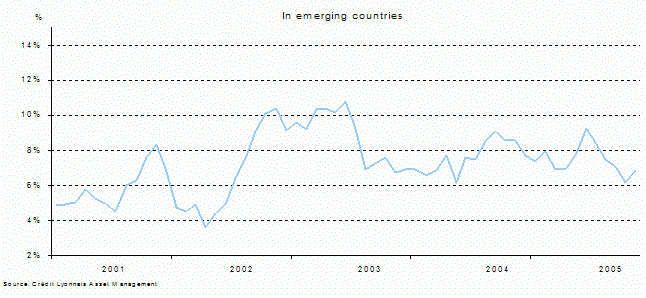Letter number 11 of December 2005
- TOPIC
- STATISTICS
- RESEARCH
- QUESTIONS & COMMENTS
News : Deferred taxation
1. Deferred taxation does not represent an amount of tax due to or owed by the tax authorities, but consists in accounting entries with no economic underpinnings that do not reflect any cash flows.
2. It is the product of accounting entries triggered by differences between book values and tax bases (on the balance sheet) or between accounting and tax treatments (on the income statement). The corresponding double entry is made either on the income statement or to shareholders’ equity.
3. Although deferred taxes must be booked in the consolidated financial statements, this is not systematically required in the annual accounts, and in the vast majority of cases, they are not recognised in the annual accounts. Does this mean that the annual accounts are wrong? Of course not!
4. Finally, deferred taxes are often a purely intellectual construction, and the source of a lot of confusion. Frequently, the less rigorous analyst will treat them as elements of working capital.
Unfortunately, it is unlikely that deferred taxes will disappear in the near future. Already for one third of European Eurostoxx 50 companies, they account for over 20% of equity capital.
There are three main situations in which deferred taxes are recognised:
- When there are losses
- When provisions that are not immediately tax deductible are recognised
- When assets are revalued, for example after an acquisition (1).
1. The simple case of losses
A group makes a pre-tax book and tax loss of 100. From a tax point of view, the tax due is zero. From an accounting point of view, and if there is reason to believe that the company is likely to make profits in the future that will enable it to use this tax loss carryforward, the loss will be reduced by a tax credit of 34 (2). Accordingly, it will be booked at 66. In order to balance the books, a tax credit carryforward of 34 will be recognised in the balance sheet on assets side.
The following year, if our group makes an accounting and taxable profit of 100, it will not pay any tax, as the tax loss carryforward created that year will be set off against the tax due. From an accounting point of view, we’ll recognise a theoretical tax expense of 34 and reduce the deferred tax recognised previously in the balance sheet to 0.
This example clearly shows that the deferred tax credit was created by reducing the amount of the net accounting loss and thus increasing equity by the same amount. From a financial point of view, it is only of value if future operations are able to generate enough profits. But under no circumstances can it be considered as an ordinary asset that could be sold for cash. And it is most certainly not an element of working capital as it does not result from the time lapse between the billing date and the payment date. We’ll consider it as a fixed asset. At the worst, it could be reversed against shareholders’ equity, if there are serious doubts about the company’s future ability to make profits.
2. The case of reserves that are not immediately tax deductible
In some countries, reserves for retirement benefits, restructuring and environmental risks are not tax deductible when they are recognised. They are only tax deductible when the related expense is paid. The accounting rule for consolidated accounts is different because allocations to these provisions are treated as tax deductible when they are recognised. This is what results in the gap between real flows and the accounting treatment.
Let’s go back to our group that is now making pre-tax profits of 100 per year. This year, it must allocate 100 to a reserve to cover a risk that may materialise in three years. From a tax point of view, the net result is 66 as the reserve is not tax deductible and the tax recognised is 34. From an accounting point of view, as the reserve of 100 is a cost, the net result is 0. The tax effectively paid (34) appears on the income statement but is neutralised by a deferred tax income of 34 which, in order to balance the books, is also recorded on the assets side of the balance sheet. Finally, the net tax recorded on the income statement is 0.
In three years, all other things being equal, the net tax result is 0 since the cost is tax deductible, and the tax effectively paid that year is thus 0. From an accounting point of view, the written back provision cancel out the expense, so the pre-tax result is 100 – 100 (cost) + 100 (provision written back) = 100. The tax recognised by accountants is 34 which is split into 0 tax paid and 34 recognised through deduction from the deferred tax credit recognised in the balance sheet three years ago, which is thus used up.
The deferred tax credit carried on the balance sheet for three years has a cross-entry under equity capital that is higher by 34. This is tax that has already been paid but from an accounting point of view is considered as a future expense. Unlike inventories of raw materials which have been paid for and which are also a future expense, deferred tax has no monetary value.
You can now see why we started out by saying that deferred taxes are a “purely intellectual construction”. You can also see how difficult it is for any analyst to deal with this “asset”, which isn’t really one, notwithstanding its name, and which only exists to set off an expense which has been paid (the tax), but which for arbitrary reasons is only recognised later in a group's consolidated financial statements.
The financial treatment we advocate (3) for deferred tax is much simpler. It is deducted from the reserve under liabilities (so that it appears after tax) or from equity to reverse the initial entry.
3. Revaluing assets
Revaluing an asset when it is first consolidated or subsequently (when tested for impairment) has two consequences:
- The taxable capital gains if the asset is sold will be different from the book value of the capital gains recorded in the consolidated financial statements.
- The basis for depreciation will be different, and will thus generate deferred taxes.
A group acquire a new subsidiary which has land recorded on its balance sheet at its initial acquisition value of 100. This land is revalued in the consolidated financial statements at 150 .
We will then book a deferred tax liability of (150 – 100) x 34% = 17 in the consolidated financial statements. What is this liability from an economic point of view? It is the difference that will be booked in the consolidated financial statements between the tax actually paid on the day when the land is sold at a price of P - (P – 100) x 34% and the tax that will be recognised (P – 150) x 34 %. The cross-entry on the balance sheet for this deferred tax is a lesser reduction of goodwill, which is reduced not by 50 but by (50 - 17).
Is this a debt owed to the Receiver? Clearly not, since the land would have to be sold for a tax liability to appear and then for an amount of (P - 100) x 34% and probably not 17! Let’s just carry on with our intellectual abstractions, which are becoming as clear as mud. What do we advice our readers to treat this deferred tax liability? Deduct it from goodwill.
As for the case of the asset that has been revalued but that is depreciable?
If you’ve followed up to here, you should be starting to see a final picture made up of the initial recognition of the deferred tax liability being gradually reduced over the duration of the residual life of the asset by deferred tax credits due to the difference between a tax depreciation calculated on the basis of 100 and book depreciation calculated on the basis of 150.
Recognising tax in accordance with rules that differ from those applicable to tax due, gives rise to deferred tax credits and liabilities. The advantages they may bring seem to us to be almost completely outweighed by the confusion they create, especially on the balance sheet. Deferred taxes should not be recognised. Let’s keep things simple.
(2) At a corporation tax rate of 34%.
(3) See chapter 6 of the Vernimmen.
Statistics : Equity risk premiums accross the world
Research : Stock options for all?
Three main explanations have emerged from the many that have been put forward by economic theory research. There is the link between incentive and effort (agency theory (1)), the selecting employees who are optimistic about the company’s future development, and employee loyalty. Paul Oyer and Scott Schaefer (2) have looked at the key arguments behind these three theories and have tested the compatibility of the underlying assumptions with available data on US corporations.
1. According to agency theory, the shareholder is not able to appreciate the full extent of the effort that an employee or manager puts into the company. Accordingly, it is difficult to link compensation directly to effort. In order to incentivise employees, their compensation should be made dependent on the company’s performance, for example, by giving them stock options. According to Bengt Homstrom and Paul Milgrom (3), the number of stock options given out is higher if:
- the value of the company depends substantially on staff effort
- the cost to the employee of making an extra effort does not rise too quickly
- the employee is not too averse to risk
- the value of the company is not too volatile
As it is not generally possible to make empirical observations on the first three points, the authors tested the link between the number of stock options and the volatility of the share, a theory which they then rejected. They found that companies in which stock option plans were the most widespread were generally those (for listed companies) with the most volatile share prices. Accordingly, it would seem that incentivisation does not explain the general granting of stock options.
2. Since the link between the employee's performance and the company's performance (and thus the value of the stock options) is too weak, Oyer and Schaefer look into another possible reason - attracting staff who will be optimistic about the future value of the company. The main benefit resulting from the selection of optimistic employees is that people who are upbeat tend to work with greater efficiency.
This time, the data confirms the validity of the theory. Companies with a more volatile share are generally those on which opinions (both upbeat and downbeat) diverge the most. The more frequent introduction of stock options at these companies could be explained by the fact that they are better at selecting more optimistic staff.
Finally, according to staff retention models, stock options are a way of creating an opportunity cost for employees leaving the company. This is more efficient than a deferred payment in cash if the value of the company is positively correlated to the situation on the job market in the same sector.
In this case, if employees receive attractive offers for other jobs, the fact that they will have to give up their stock options will make changing jobs more expensive for them (because the value of the shares will have risen). The authors found that stock option plans are more widespread in companies with share prices that are the least in line with average share prices in the sector.
Furthermore, if we combine the motives for staff selection and retention, we are able to see a closer link between the number of stock options paid to employees and the underlying economic assumptions.
Finally, the article shows that the economic justifications for using large-scale stock option plans covering all employees are not the same as for plans covering management only. It is well known that the interests of managers who own stock options are aligned with those of the shareholders. Owning stock options will thus be an incentive to managers to put in more effort, in accordance with agency theory. This research shows that awarding stock options to all employees is evidence of a company's determination to select staff who are optimistic about the future of the company, and who will accordingly be more productive and, more importantly, less likely to leave the company.
(2) Why do some firms give stock options to all employees? : An empirical examination of alternative theories, Oyer, P. and Schaefer, S. Journal of Financial Economics (April 2005).
(3) Aggregation and linearity in the provision of intertemporal incentives, Holmstrom, B and Milgrom,P.R. Econometrica (1987).
Q&A : In a merger, how do you decide which company should be taken over and which should be doing the taking over?
- In some countries, the tax issue is the main factor in deciding which way the merger should go. The acquired company lost all of its tax loss carryforwards, while the acquiring company is allowed to hold onto them.
In other countries, it is possible for the company resulting from the merger of two companies to hold onto the tax loss carryforwards of the company that is acquired, providing that the merger is not being carried out solely for tax reasons. This reduces the importance of the tax issue in deciding who should take over whom.
- Whether the company is listed or not is a factor, since in a merger between a listed and an unlisted company, it is likely that the listed company will take over the unlisted one in order to simplify administrative procedures and to avoid an exchange of shares for the hundreds or the thousands or even hundreds of thousands of shareholders of the listed company. This is why in April 2004, L’Oréal, a listed group, took over its unlisted parent company Gesparal (which had a 53% stake in L’Oréal), and not the other way round.
- There are also psychological reasons why sometimes it makes more sense to continue trading under the name or structure of an entity which has been in existence for a very long time and which has great sentimental value for management and shareholders. In such cases, it is the oldest structure that becomes the acquiring company.
- There are also some managers who believe that they will be in a better position within the new structure if their company is the acquiring rather than the acquired company. There are others who wish to make a symbolic statement about where the power lies.
- There may also be accounting reasons. In some countries, the annual accounts of the acquired company are revalued when on completion of the merger, the shareholders of the acquired company do not take control over the new entity. If they do, the operation is recorded at its book value.
- There may also be accounting reasons. In some countries, the annual accounts of the acquired company are revalued when on completion of the merger, the shareholders of the acquired company do not take control over the new entity. If they do, the operation is recorded at its book value.
- There are of course legal considerations when agreements signed by the acquired company contain a change of control clause, for example in the concessions sector or for loan agreements, with some loans falling due immediately. This is how TF1 was able to take full control over Eurosport after its partner Canal+ was merged into Vivendi Universal.
- Finally, there are those who are obsessed with EPS who are keen for the acquiring company to be the one with the highest P/E ratio, so the merger will be accretive in terms of EPS. Our regular readers will know how cautiously we tread when it comes to EPS (1) .




